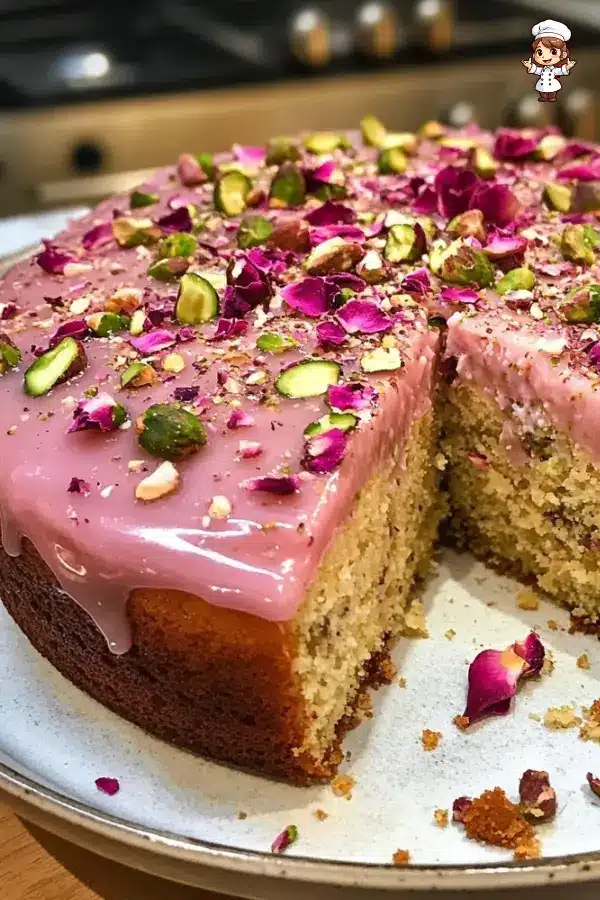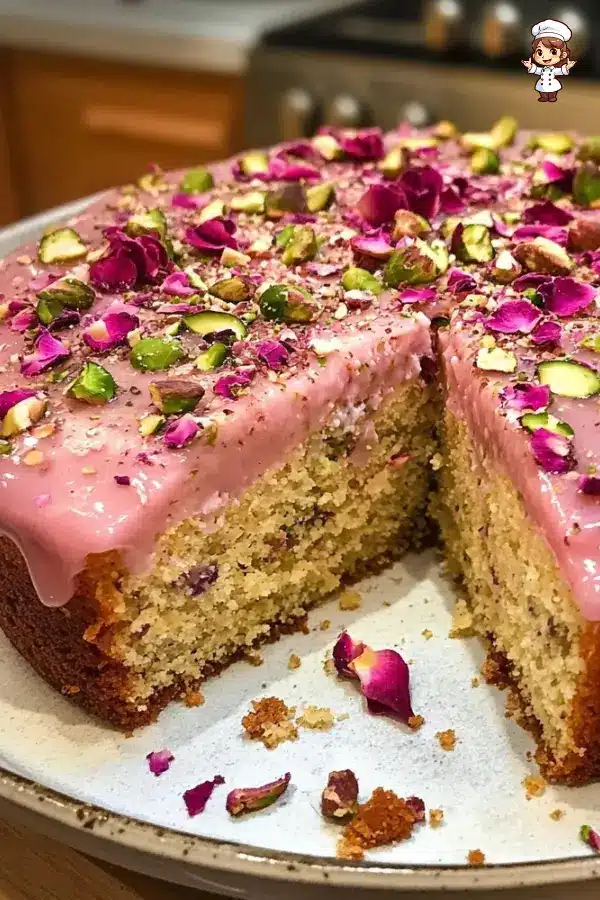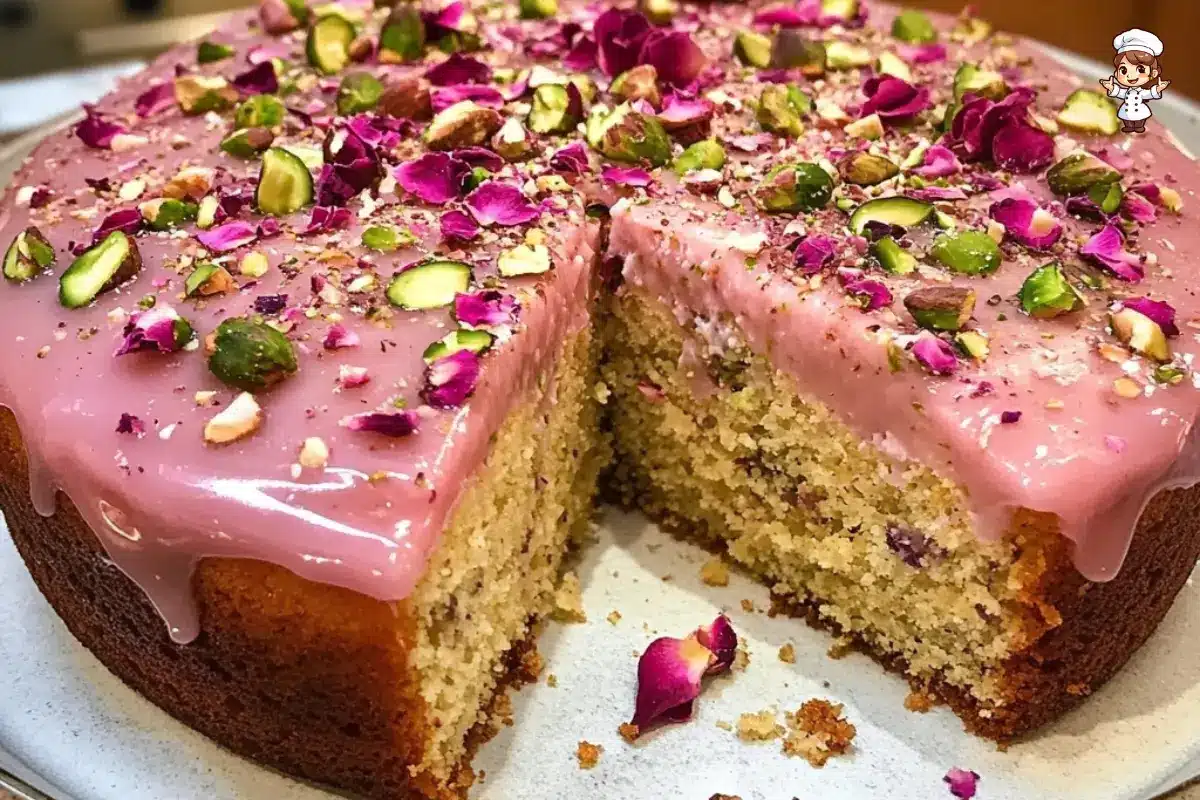There’s something incredibly enchanting about the Persian Love Cake, which has a rich history, culture, and flavorful dessert. Infused with exotic ingredients like rosewater, cardamom, and almonds, this cake isn’t just a treat for the taste buds but an experience for the senses. Whether making it for a special occasion or simply because you want to indulge in something sweet and aromatic, the Persian Love Cake recipe will surely become a favorite in your baking repertoire.
In this article, we’ll dive deep into everything you need to know about creating this delicious cake. From understanding its origins and key ingredients to exploring the variations and garnishes that make it unique, we’ll guide you through each step. Let’s start with the basics—what exactly is Persian Love Cake, and why has it captured the hearts of so many?
Key Ingredients in Persian Love Cake

Flour and Nuts: Almonds, Semolina, and More
The Persian Love Cake recipe starts with a foundation of unique and flavorful ingredients, making it stand out from traditional cakes. One of the key components is almond flour, which lends a nutty richness and delicate texture to the cake. Unlike regular all-purpose flour, almond flour gives the cake a slightly denser, yet moist, crumb.
Some variations of this cake use semolina flour, imparting a grainy texture and a slightly more rustic feel. Both almond flour and semolina pair perfectly with the other ingredients, helping create a flavor profile that’s both rich and aromatic. Whether making a classic Persian Love Cake or experimenting with a gluten-free version, these flours are the building blocks of the cake’s beautiful, light, yet satisfying texture.
Aromatic Spices: Cardamom and Rosewater
The spices used in the Persian Love Cake recipe make all the difference when it comes to flavoring. Cardamom is the star here. Its sweet, slightly spicy, and citrusy notes give the cake its signature taste. A pinch of ground cardamom goes a long way, adding a warmth and depth that’s simply irresistible. This spice is what makes the cake so unique and unforgettable.
And, of course, rosewater is a crucial ingredient. Often associated with Persian desserts, rosewater adds a floral fragrance that’s both subtle and enchanting. The scent of rosewater pairs beautifully with the cardamom and almond flour, resulting in a cake that’s as aromatic as it is flavorful. If you’ve never used rosewater before, don’t be shy—it’s a key player in making this cake special.
Pistachios and Other Garnishes
A final touch of pistachios—finely chopped and sprinkled on top—adds crunch and a beautiful pop of green. The pistachios contrast perfectly with the delicate cake, providing texture and a nutty flavor that complements the other ingredients. Additionally, dried rose petals make for a stunning garnish, adding a touch of elegance and completing the visual appeal. Together, these garnishes turn your Persian Love Cake into a visually pleasing dessert full of layered flavors.
How to Make Persian Love Cake: Step-by-Step Recipe
Preparing the Dry Ingredients
Preparing the dry ingredients is the first step in the Persian Love Cake recipe. Whisk together your almond flour, all-purpose flour, baking powder, and a pinch of salt in a medium bowl. Don’t forget the ground cardamom and the lemon zest—they add that distinct, fragrant touch that will make your cake smell incredible while baking. These dry ingredients combine to give the cake its structure and flavor base.
Make sure everything is evenly mixed so that the flavors will spread throughout the batter when the wet ingredients are added. Set the bowl aside while you focus on the wet ingredients.
Mixing the Wet Ingredients
In a separate large bowl, beat the sugar, melted butter, eggs, and yogurt together. This combination gives the cake its soft, moist texture. If you’re using rosewater, now’s the time to add it, giving your cake its signature floral fragrance. The yogurt (or sour cream) helps make the cake extra tender and adds a slight tang that balances the sweetness.
Whisk until the mixture is smooth and well combined. The goal is to create a creamy, silky batter that’s easy to fold into the dry ingredients. It’s tempting to rush this part, but take time and ensure everything is well incorporated.
Baking the Cake to Perfection
Now, it’s time to combine the wet and dry ingredients. Gradually fold the dry mixture into the wet mixture, ensuring no overmix. Overmixing can lead to a denser cake; we want light and fluffy. Once everything is just combined, gently fold in the finely chopped pistachios. This will ensure the nuts are evenly distributed without breaking them down into small bits.
Pour the batter into a greased and lined 20 cm (8-inch) round cake pan, smoothing the top with a spatula. Bake the cake in a preheated oven at 175°C (350°F) for about 35 to 40 minutes. You’ll know the cake is made when it’s golden brown on top and a toothpick inserted into the center comes out clean.
Let the cake cool in the pan for about 10 minutes, then transfer it to a wire rack to cool completely. This will allow the flavors to settle, making the cake easier to handle when you’re ready to glaze it.
Variations of Persian Love Cake
Gluten-Free and Dairy-Free Options
If you’re looking to make the Persian Love Cake recipe accessible to those with dietary restrictions, there are plenty of ways to adapt it. For a gluten-free version, simply swap out the all-purpose flour for a high-quality gluten-free flour blend. You can also replace the almond flour with a coarser flour, like rice flour, for a slightly different texture.
As for the dairy-free crowd, substituting unsalted butter with plant-based options, like coconut oil or vegan butter, will maintain the cake’s richness. You can also opt for almond or coconut milk instead of yogurt for that creamy, tangy flavor. These changes allow anyone to enjoy this delicious cake without sacrificing flavor or texture.
Adding Saffron for Extra Flavor
If you want to elevate your Persian Love Cake even further, consider adding saffron—a signature Persian ingredient. Saffron is known for its vibrant yellow color and its subtly floral, earthy flavor. When combined with the floral notes of rosewater and the warmth of cardamom, saffron enhances the cake’s complexity. Just a pinch will go a long way, so don’t overdo it. To use saffron, steep it in warm water or milk before incorporating it into the wet ingredients. The result? A richer, more luxurious Persian Love Cake.
Other Flavor Enhancements
If you’re feeling adventurous, why not add other unique flavors to your Persian Love Cake recipe? A bit of orange blossom water could be a wonderful twist, complementing the rosewater and adding a citrusy brightness. For a more decadent touch, you might want to drizzle a lemon glaze over the top, which would nicely balance the sweetness of the cake with its tartness. Experiment with different extracts and oils—there are endless ways to personalize this cake while keeping its Persian roots intact.

Persian Love Cake Glaze and Frosting
Classic Rosewater Glaze
The final touch to the Persian Love Cake recipe is the glaze, which adds a shiny, sweet finish to the cake. The simplest glaze is made by whisking together powdered sugar with rosewater. The rosewater flavor shines through, enhancing the already floral cake. You can adjust the amount of rosewater depending on how strong you want the flavor to be. If you find the glaze too thick, add a little water or lemon juice to achieve the desired consistency.
Once your cake has cooled, drizzle the glaze over the top, allowing it to drip down the sides for that beautiful, glossy look. Add a few drops of pink food coloring to the glaze for a little extra flair to give it a delicate hue that matches the rose petals and pistachios.
Lemon Syrup or Icing for Added Zest
Consider making lemon syrup or icing if you want to add a refreshing twist to the traditional rosewater glaze. The acidity and tartness of the lemon provide a pleasant contrast to the sweetness of the cake. To make a simple lemon syrup, mix fresh lemon juice with a little sugar and heat it until the sugar dissolves. For an icing, combine powdered sugar with lemon juice for a thicker consistency that coats the cake beautifully.
Whichever option you choose, the glaze or syrup will add that final touch of sweetness while balancing the fragrant flavors of rosewater and cardamom.
For more delicious recipes, check out our article on Almond Nut Cake Recipes, where you can explore another fantastic treat that’s rich in flavor and easy to make!
Tips for Perfecting Your Persian Love Cake
Temperature and Baking Tips
When making the Persian Love Cake recipe, keeping an eye on the baking process is crucial. First, ensure your oven is preheated to 175°C (350°F) before placing the cake inside. This ensures the cake bakes evenly right from the beginning. It’s also important to use room-temperature ingredients—butter, eggs, and yogurt should all be at room temperature for smoother mixing and better texture.
While baking, avoid opening the oven door too often, as this can cause the temperature to fluctuate and may affect how the cake rises. The cake typically bakes for about 35 to 40 minutes, but ovens vary, so it’s a good idea to start checking with a toothpick after 30 minutes. When it comes out clean, the cake is done!
How to Avoid Common Mistakes
One of the most common mistakes when baking a Persian Love Cake is overmixing the batter. To prevent this, gently fold the dry ingredients into the wet ingredients, and don’t mix too vigorously. Overmixing can lead to a dense texture instead of the light, fluffy crumb we want. If you’re making a gluten-free version, keep in mind that gluten-free flours can behave differently, so you may need to adjust the moisture content to keep the cake soft and moist.
Another tip is to ensure your cake is completely cooled before glazing it. Applying a glaze while the cake is still warm can cause it to melt into the cake too much, ruining the visual effect. So, let it cool fully on a wire rack before adding the finishing touches.
Serving and Storing Persian Love Cake
Serving Suggestions
The Persian Love Cake recipe is best enjoyed with a hot cup of tea or coffee. Its fragrant, floral notes make it a perfect accompaniment to a warm beverage. For special occasions, consider serving the cake on a beautiful platter, garnished with extra pistachios and dried rose petals for a stunning presentation. It also pairs wonderfully with fresh berries or a dollop of whipped cream for added richness.
If you’re serving this cake at a gathering, it’s also a great idea to slice it into smaller portions, as the cake is quite rich. This way, everyone gets a taste without feeling overwhelmed by the sweetness.
How to Store Leftover Cake
If you happen to have leftovers (though that’s unlikely!), storing your Persian Love Cake is simple. Just place it in an airtight container and store it at room temperature for up to 3 days. For longer storage, you can wrap the cake tightly in plastic wrap and freeze it for up to 2 months. When ready to eat, allow it to thaw at room temperature, and the cake will remain just as moist and flavorful as when you first baked it.
Frequently Asked Questions (FAQ)
Can I make Persian Love Cake in advance?
Yes, you can make the Persian Love Cake recipe ahead of time! Making it a day in advance can improve the flavor, as the spices and rosewater have more time to develop. Store the cake in an airtight container at room temperature to keep it fresh. If you’ve made a glaze, wait until just before serving to drizzle it over the cake so it doesn’t melt into it during storage.
Can I substitute ingredients in this recipe?
Certainly! There are several substitutions you can make in the Persian Love Cake recipe. For example, if you don’t have almond flour, you can use a different nut flour or even all-purpose flour if you’re not concerned about the gluten-free version. If you can’t find rosewater, orange blossom water or even a hint of vanilla extract could work as alternatives to provide a fragrant, floral flavor. Remember that substitutions may slightly alter the taste or texture, but they can still result in a delicious cake.
Is Persian Love Cake gluten-free?
The traditional Persian Love Cake recipe is not gluten-free due to all-purpose flour. However, it’s easy to make it gluten-free by substituting the all-purpose flour with a gluten-free flour blend or even using more almond or semolina flour. If you’re using almond flour, make sure the consistency of the batter remains just right by adjusting the other ingredients slightly to accommodate the change.
Print
Persian Love Cake Recipe
- Total Time: PT1H
- Yield: Serves 8
- Diet: Gluten Free
Description
This Persian Love Cake recipe is a beautifully aromatic dessert that combines the delicate flavors of rosewater, cardamom, and almond flour, topped with pistachios and rose petals. It’s a rich, nutty, and fragrant cake perfect for any special occasion. The floral notes of rosewater and the warmth of cardamom provide a delightful balance, making it a unique and irresistible treat that will impress anyone who tries it.
Ingredients
- 100 g almond flour (1 cup)
- 100 g all-purpose flour (3/4 cup)
- 150 g granulated sugar (3/4 cup)
- 115 g unsalted butter, melted (1/2 cup)
- 2 large eggs
- 1 tsp rosewater
- Zest of 1 lemon
- 1/2 tsp ground cardamom
- 1 tsp baking powder
- 1/4 tsp salt
- 2 tbsp plain yogurt or sour cream
- 50 g shelled pistachios, finely chopped (1/3 cup)
Instructions
- Preheat the oven to 175°C (350°F) and grease a 20 cm (8-inch) round cake pan.
- In a medium bowl, whisk together almond flour, all-purpose flour, baking powder, salt, cardamom, and lemon zest.
- In a large bowl, whisk together sugar, melted butter, eggs, yogurt, and rosewater until smooth.
- Gradually fold the dry ingredients into the wet mixture until just combined.
- Gently fold in the chopped pistachios.
- Pour the batter into the prepared pan, smoothing the top.
- Bake for 35–40 minutes, or until golden and a toothpick inserted comes out clean.
- Let the cake cool for 10 minutes in the pan, then transfer to a wire rack to cool completely.
- For the glaze, whisk together powdered sugar and rosewater (or lemon juice) until smooth, then drizzle over the cooled cake.
- Garnish with crushed pistachios and dried rose petals before serving.
Latest Amazon Finds
Notes
- You can substitute the yogurt with sour cream for a richer texture.
- If you want to make it more festive, consider adding a few strands of saffron to the batter for an extra layer of flavor.
- For a dairy-free version, substitute the butter with coconut oil and use a dairy-free yogurt alternative.
- Prep Time: PT20M
- Cook Time: PT40M
- Category: Dessert
- Method: Baking
- Cuisine: Persian
Nutrition
- Serving Size: 1 slice
- Calories: 310 kcal
- Sugar: 20 g
- Sodium: 150 mg
- Fat: 18 g
- Saturated Fat: 7 g
- Unsaturated Fat: 10 g
- Trans Fat: 0 g
- Carbohydrates: 35 g
- Fiber: 2 g
- Protein: 4 g
- Cholesterol: 60 mg
Keywords: Persian Love Cake, rosewater cake, cardamom cake, almond flour cake, gluten-free Persian cake, pistachio cake, rosewater dessert




